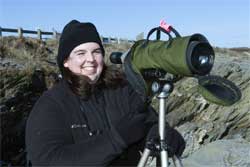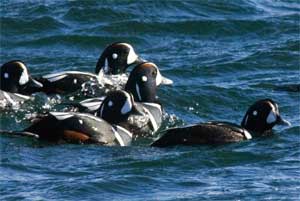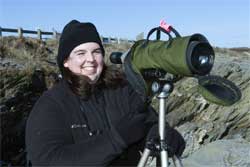 URI student research highlights importance of Beavertail, Sachuest
URI student research highlights importance of Beavertail, Sachuest
KINGSTON, R.I. – February 13, 2007 – An analysis of historic records and current observations of the rare harlequin duck in Rhode Island waters in winter has found that populations have increased at about 3 percent per year since 1975.
That’s good news for the colorful species whose entire East Coast population numbers just 1,800, according to Christine Caron, a University of Rhode Island graduate student and a Warwick resident.
More than half of the eastern population in winter is found in the waters along the coast of Maine, but Sachuest Point National Wildlife Refuge in Middletown, R.I. and Beavertail Point State Park in Jamestown, R.I. have become the species’ southern stronghold. Caron counted approximately 150 harlequin ducks in Rhode Island during the winter of 2006. Most were at Sachuest, with smaller numbers at Beavertail and Sakonnet Point in Little Compton, though the birds probably move regularly among all three sites.
“The population at Beavertail is much more recent,” said Caron, a native of Auburn, Maine who taught biology at Lincoln High School before enrolling at URI for a master’s degree in environmental science and management. “There were very few individuals at Beavertail in the 1980s and 90s, but since 2001 there has consistently been 20 or more birds there every winter.”

Caron believes that the reason for the population gains at Beavertail is that the increasing number of birds at Sachuest through the 1990s forced some harlequin ducks to look nearby for appropriate habitat.
Small ducks with stubby beaks, harlequins are slate blue and chestnut in color with white crescent markings on their head and sides. They breed along inland streams in Canada and winter along rocky coastal areas where they feed on invertebrates and small fish. At night they rest in flocks 1 to 2 miles off shore.
In addition to surveying how many birds were found in Rhode Island waters, Caron analyzed changes in their abundance at high and low tides and during morning and afternoon timeframes. She found little difference among the varying conditions, though she said that other researchers have found that the birds were more likely to remain in their nighttime flocks offshore during bad weather.
Caron’s analysis of harlequin duck numbers in Rhode Island included an examination of Christmas Bird Count data since the 1950s, U.S. Fish and Wildlife Service winter wildlife surveys since 1992, and annual bird surveys of Beavertail since 1984 by Chris and Candy Powell.
According to historical estimates, harlequin duck numbers along the East Coast peaked at about 5,000-10,000, but hunting pressures reduced the population to approximately 1,000 before hunting them was banned in 1990. The Pacific Coast population of harlequin ducks totals about 200,000-300,000 individuals.
URI News Bureau Photo by Michael Salerno Photography.

